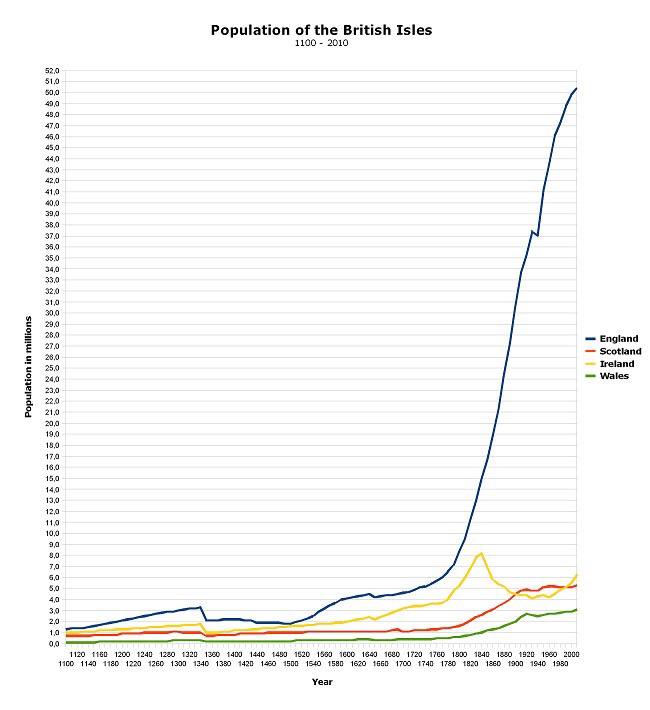The second most amazing thing, after the growth of the population of England shown in this graph recently posted on Twitter by Myko Clelland, is the decline in the population of Ireland that started, but didn't end with the famine of the 1840s.
Through the 18th century to the famine the population trend in Ireland was following much the same trajectory as in England.
What would have happened if the potato blight had not struck, famine had been avoided and parallel population growth continued?
In 1840 England's population was 15 million, Ireland's 9 million—60 per cent of England's.
In the year 2000 England's population was 50.3 million. 60 per cent of that is 30 million. Compare that to Ireland's actual population that year of 6.2 million.
30 million living Ireland with an area of 84,421 km² would mean an average 354 people per km²—about the same as Belgium today. The UK has 255 people per km².
Would there have been a development path to sustain a population of 30 million? Is there a hint in the censuses of 1841 and 1851 which, in addition to showing the population decline, records a widespread if small increase in the ability to read and write (see https://irishfamineproject.com/)? The National School system had been introduced in 1831.
Or would there have been continued major migration, as was the Irish experience before the famine and after it? Ireland may be thought of as green, but through the ages many have seen the grass to be greener on the other side of the hill.
Since 2006, Canada's Anglo-Celtic Connections has been an independent view of family history resources and developments seen from an Ottawa perspective.
Search This Blog

Genealogy Tweets
Links
Subscribe via email
Blog Archive
-
▼
2018
(925)
-
▼
March
(85)
- OGS revives CanadaGenWeb's Cemetery Project
- British Newspaper Archive additions for March
- LAC Signatures: Spring/Summer 2018
- Frederick Twiss Thomson: CWGC Beechwood
- Who do you think is coming to the BIFHSGO conference?
- New on Findmypast
- Free Ancestry access this weekend
- Ancestry adds Yorkshire, England: Church of Englan...
- Ancestry updates England & Wales, Civil Registrati...
- Family Tree April 2018
- The Best DNA Testing Kits of 2018!
- Ancestry First World War Pension Claim Project
- Indefinite Closure of Toronto Family History Centre
- IGRS Updates Early Irish BMD Indexes
- Origin and Distribution of English Surnames
- The History of the British Isles: Every Year
- Irish Research: A Practical Guide
- Deep Roots, Promising Future
- The Lost Villages of the St. Lawrence River
- Findmypast British additions
- Ancestry adds Kent, England, Extracted Parish Reco...
- Discover Your Roots: Ottawa Genealogy and Local Hi...
- Now we are 37 million?
- Two genetic genealogy success story videos
- TheGenealogist adds Meritorious Service Medal Roll.
- Honouring Sir Arthur Doughty
- OGS Ottawa Branch March Meeting
- TNA tests handwriting recognition in PROB 11 will ...
- HSO March Meeting
- MyHeritage DNA features in two of three Legacy web...
- Canadian Centre for the Great War
- Irish Origins on YouTube
- Birmingham Burial Records
- Help determine priorities of the National Heritage...
- Gilbert Ross Slack: CEF Beechwood
- Adding to the Irish Records at Findmypast
- Ireland population and migration
- OGS weekly eNewsletter
- The Irish in Upper Canada, 1819-1840
- St Patrick's Day 1838
- Two additions to GGI Belfast 2018 on YouTube
- FreeBMD March Update
- CEF Service Files Update for March 2018
- Gene-O-Rama 2018
- $1 million to support Canadian digitization
- Churches of East Anglia
- Kingston Branch OGS March Meeting: Irish Settlemen...
- AncestryDNA St Patrick Offer
- Celebrating 12 Years Blogging
- Predicting places from names in the UK
- Quinte Branch OGS March Meeting
- YouTube: Using autosomal DNA to maximum effect
- Family Finder $59US
- DNA distinguishes French-Canadians from different ...
- OPL helps in Finding Birth Families
- FamilySearch adds to Oldham Cemetery Registers, 17...
- The Wright Papers
- Findmypast adds to Monmouthshire Electoral Registe...
- Findmypast has some indexes to Irish births and ma...
- Ottawa Branch OGS Funding for Genealogical Projects
- Help Release the 1926 Irish Census
- RootsIreland discount
- TheGenealogist adds UK Outbound Passenger Lists fo...
- UEL Association of Canada meeting on Saturday, Mar...
- Fintan
- Cumberland Township Historical Society reaches agr...
- YouTube: Irish DNA Atlas
- Wiggins and Wiggins' Storm Anniversary
- Berton Hurlbert: CWGC Beechwood
- Harvest Your Family Tree Conference, Kelowna, 28-3...
- Game of Genes
- Early Logging in Cumberland Township
- Parking Charges at TNA
- #NotAtRootsTech
- Gene-O-Rama 2018
- Which DNA Company?
- Bethnal Green Disaster
- Important additions to MyHeritage
- Major Upgrade to MyHeritage Chromosome Browser
- Forthcoming Family History Books
- Answering a Query: "Your Genealogy Today: March/Ap...
- Monthly backup nag
- Ottawa DNA Group Meeting
- Findmypast adds address search to UK census records
- Your Genealogy Today: March/April 2018
-
▼
March
(85)

No comments:
Post a Comment